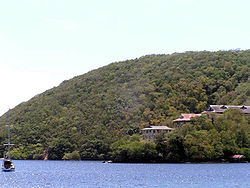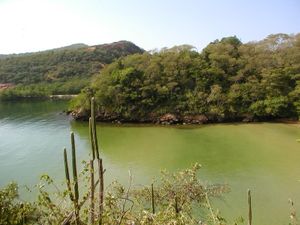

located at 10° 41' north latitude
and 61° 45' west longitude
. The island is 3.642 km² (900 acre
s) in area. It is one of the "Bocas Islands", which lie in the Bocas del Dragón
(Dragons' Mouth) between Trinidad
and Venezuela
. Chacachacare in the westernmost of the Bocas Islands which belong to Trinidad and Tobago. Patos Island
, which lies further west, was part of Trinidad and Tobago until 1942 when it was ceded to Venezuela.
History
It was originally named El Caracol (the Snail) by Christopher Columbus
because of its shape. At various times in its history Chacachacare has served as a cotton
plantation, a whaling
station and a leper colony
.
"Chacachacare, at the west of the first Boca, is horseshoe shaped and very hilly. The hills slope towards the inside of the horseshoe. At the junction of the arms of the horseshoe, the land is flat and marshy. At times of spring tides or in rough weather the sea often passes over the isthmus
IsthmusAn isthmus is a narrow strip of land connecting two larger land areas usually with waterforms on either side.Canals are often built through isthmuses where they may be particularly advantageous to create a shortcut for marine transportation...
. Boats can be hauled from calm water on the east to La Tinta, so called on account of the colour of the sand, which is black, the water being clear, but the sand beneath it makes it look black.
In 1791, there were many people living on this island, cultivating ground provisions and sugar apples (Annona squamosaAnnona squamosaAnnona squamosa a small well-branched tree or shrub that bears edible fruits called sugar-apple, species of the genus Annona and member of the family Annonaceae more willing to grow at lower altitudes than its relatives Annona reticulata and Annona cherimola making it the most widely cultivated of...
). During the time of slavery large quantities of cotton were grown, which after emancipation was abandoned. Later, when the price of cotton was very high, the industry was re-established by Messrs. Gerold and Urich. There were also three or four whaling stations carried on by Messrs. Gerold and Urich, Tardieu and F. Urich and Partners.
Looking across the Boca GrandeBoca grande-Places:*Boca Grande, Florida, United States*Boca Grande, Venezuela*Boca Grande Key, Florida, United States-Other:*Boca Grande Community Center, also known as Boca Grande School, a historic site in Boca Grande, Florida...
there is a view of the Venezuelan mountains eight miles [12.9 km] away. On a clear day they appear to be much closer. On the land side of the bay there is a fringe of deadly Manchineel treeManchineel treeThe Manchineel tree, Hippomane mancinella, is a species of flowering plant in the spurge family , native to Florida in the United States, the Bahamas, the Caribbean, Central America, and northern South America...
(Hippomane mancinella)]. Tall cacti and aloesAloesAloe may refer:*Aloe, a genus of succulent plants, which includes several species:**Aloe arborescens**Aloe aristata**Aloe camperi**Aloe dichotoma**Aloe ngobitensis**Aloe vera**Aloe wildii*Aloe Ridge Game Reserve, in Gauteng, South Africa...
grow on the cliffs on the southern shore. There is a pebbly beach—Bande de Sud—inside which there is a lagoon from what in the early days the islanders attempted to extract salt.
About 1887 a stone pier and a large house for the use of a sanatorium was erected on the island by S. Chittendon. At present there is only a lighthouse on the west and the Leper Asylum on the island."
The famous Venezuelan revolutionary, Santiago Mariño
, who later joined forces with Simón Bolivar
and was instrumental in the liberation of Venezuela from Spanish rule, used Chacachacare as a base for his successful 1813 invasion of Venezuela with a tiny band of 45 "Patriots".


on the island. It is also regularly used for camping and visits by recreational boats. Many Trinidadians go to this island, as well as Monos
and Huevos
for vacations and day trips. This is popularly referred to as "going down the islands".
The island was spotted by Christopher Columbus
on his third New World voyage on 12 August 1498, and his little fleet spent the night anchored in Monkey Harbour. He named the island 'Port of Cats' because many wildcats lived on the island. The island later became a nun
s quarters and a leper colony. In 1942, 1,000 U.S. Marines were stationed on Chacachacare and built barracks on the island. The island was abandoned by the 1980s when the nuns left their quarters and when the last leper
that was on the island died in 1984. The colony had been abandoned since.
In 1999, Donald Trump
visited Chacachacare during the Miss Universe contest and thought of having a casino and hotel built on the island; however the idea has not been pursued.
Bolo Rocks
The Bolo Rocks are a series of rocks located at the South-West point of Chacachacare. They were named after a slave named Bolo that worked for a whaling station on the island.Cabresse Island
Cabresse Island is a very small islet located just off the Northern point of Chacachacare.External links
- Chacachacare: The sad legacy of an idyllic island in the Caribbean - Tri-City HeraldTri-City HeraldThe Tri-City Herald is a daily newspaper based in Kennewick, Washington, in the United States. Owned by The McClatchy Company, the newspaper serves southeastern Washington, including the three communities of Pasco, Kennewick, and Richland ....
- Chacachacare Interactive Map - Chaguaramas Development Authority.

